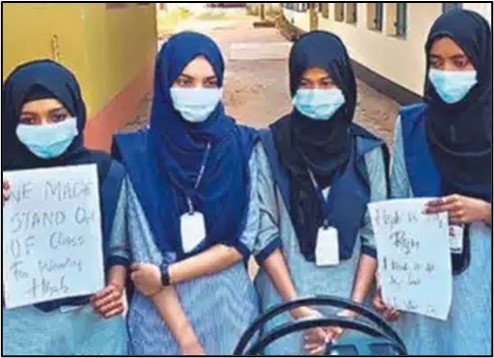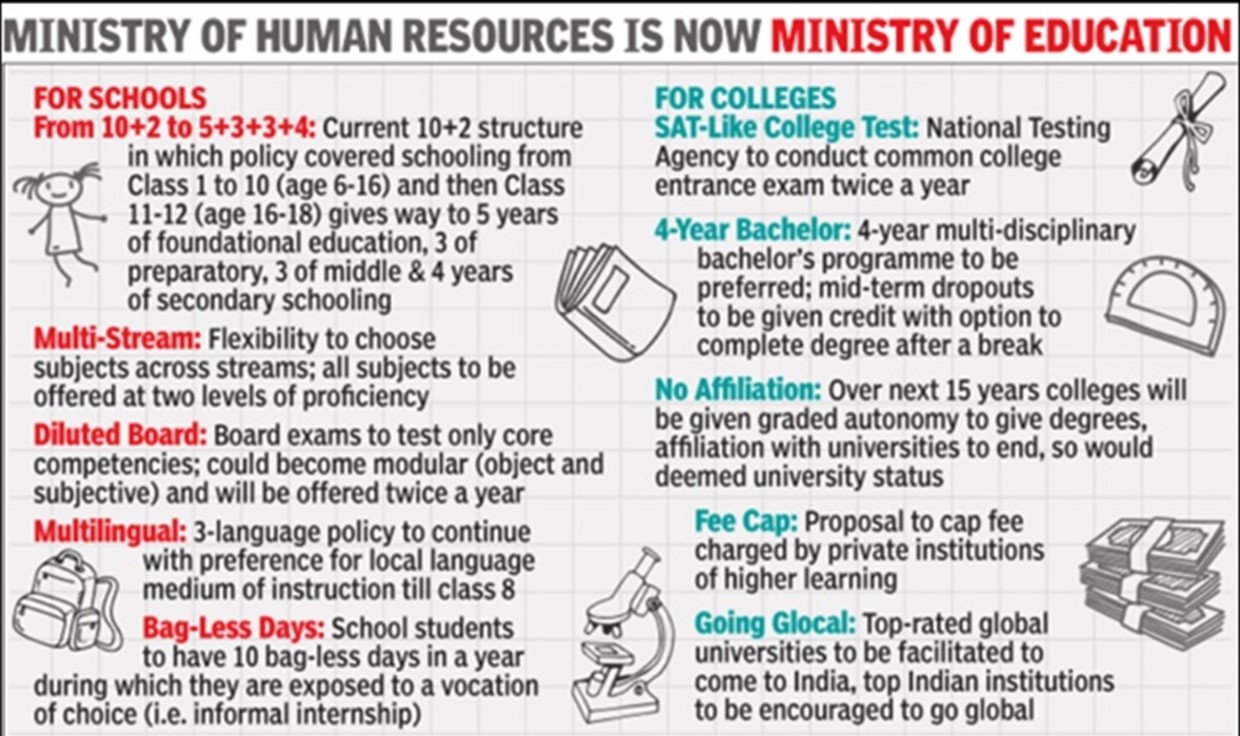Thursday, 10th February 2022
Panel report on MGNREGA
In News
A Parliamentary committee has recommended increase in guaranteed days of work from 100 to 150 under MGNREGA.
About the News
- In its report, the Standing Committee on Rural Development and Panchayati Raj has recommended for more budgetary allocation for MGNREGA, besides increase in guaranteed days of work under from 100 to 150.
- The recommendation comes at a time when the rural job guarantee scheme has become a safety net for migrant workers who returned to their villages during Covid-19, and the demand for work under it reached an all-time high in the last financial year.
- The Union Budget 2022-23, there was no increase in the allocation for MGNREGS, with the Finance Ministry retaining it at Rs 73,000 crore for the next fiscal year.
What are the major recommendations?
- Number of days: The committee is of the view that MGNREGA is a last ‘fall back’ option for numerous rural people and the amount of expenditure under it also elicits a keen interest in the scheme by the poor and marginalised.
- It has strongly recommended the Department of Rural Development (DoRD) to review the scheme of MGNREGA in such a way which could ensure an increase of guaranteed days of work from 100 to 150 days
- Revamping of scheme: Changing times and emerging challenges particularly in wake of the Covid pandemic call for revamping of the scheme.
- The Committee is of firm opinion that the ‘need of the hour’ is to further diversify the nature of works under MGNREGA besides critical evaluation of Mahatma Gandhi National Rural Employment Guarantee Act.
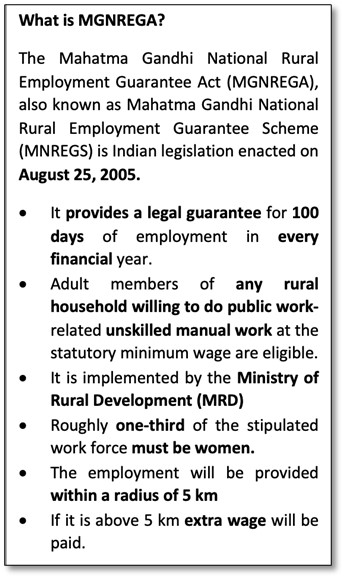
- Pragmatic allocation: The committee has recommended the DoRD to “review its budgetary demand pertaining to MGNREGA and ensure that ‘agreed to labour budget’ is made at concerned level keeping in view the expenditure of previous years”.
- Demand surge: Committee has observed that the rationale behind keeping the Budget Estimate for 2021-22 at Rs 73,000 crore was not justified when the expenditure was to the tune of Rs 1,11,170.86 crore.
- The committee has urged for more allocation as the scheme is definitely showing an increase in demand as elicited by the ever-increasing budgetary demand.
- Appropriating reverse migration: Last financial year 2020-21 witnessed a surge in demand due to reverse migration of workers from urban areas back to rural locations.
- With MGNREGA being their dependence as a last resort, the DoRD should review its budgetary demand pertaining to MGNREGA and ensure that ‘agreed to labour budget’ is made at concerned level keeping in view the expenditure of previous years.
- Delay in Payment: There has been issue of the “inordinate delay” in the payment of wages to the MGNREGA beneficiaries. Liabilities in tune of Rs 276,378.22 lakh are pending.
- Committee in all earnest has called upon the DoRD to pull up its socks and take all possible measures to wipe off the wage liabilities as soon as possible.
- Wage Rate: In the last financial year, 389.1 crore persondays were generated, and 7.55 crore households (11.19 crore individuals) availed the scheme.
- The committee also urged the Rural Development Ministry to increase the wage rates under MGNREGA by linking it with an index commensurate with inflation.
Sources:
Protection of Street Children
In News
National Commission for Protection of Child Rights (NCPCR) has organized a national level meeting in New Delhi on Identification, Rescue and Rehabilitation of Children in Street Situations with NGOs and UN agencies for seeking assistance from them.
About the News
- As per the National Commission for Protection of Child Rights, there are over 10 lakh street children, but the states have so far identified only 9,945 as per the data provided by them to NCPCR.
- Recently, the Supreme Court expressed number of children identified by the states appeared to be quite low and even the process of identification, which is the first stage of the process of rehabilitation, has not yet been completed.
- The court observed that the special juvenile police units (SJPUs) that were supposed to be created in each district have not been set up properly.
- NCPCR as per its mandate has developed a Standard Operating Procedure (SOP) 2.0 for Care and Protection of Children in Street Situations to create a convergence among the various functionaries and to ensure a more holistic approach in providing care, protection and restoration of Children in Street Situations (CiSS).
- During the program a detailed presentation was made on Baal Swaraj portal – Children in Street Situations (CiSS).
- The National Commission for Protection of Child Rights (NCPCR) devised an online tracking portal “Bal Swaraj (COVID-Care link)” for child in need of care and protection. This portal of the Commission has been created with a purpose for online tracking and digital real time monitoring mechanism of children who need care and protection.
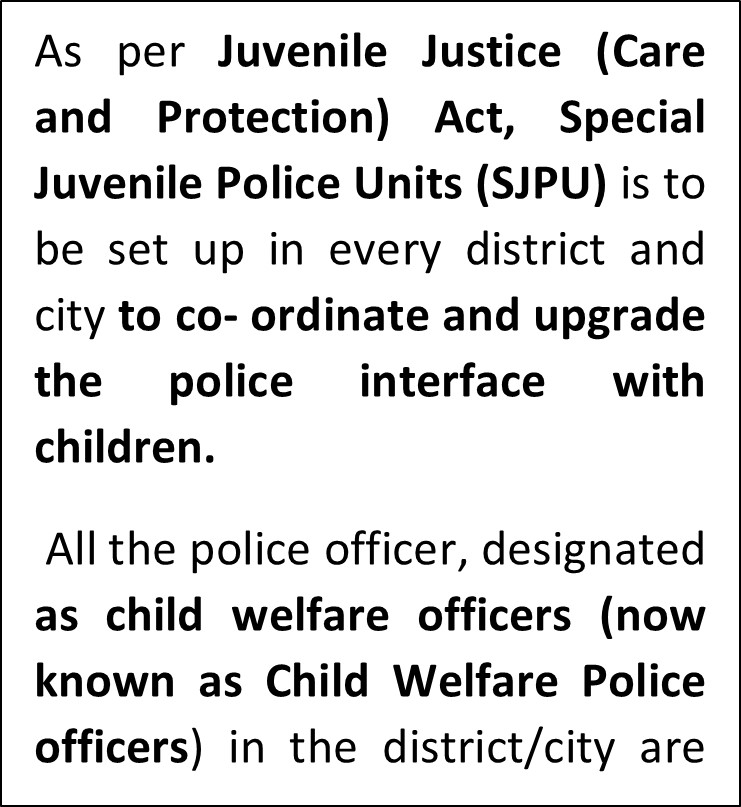
Definition of Street Children
- Street children as defined by United Nations (UN) are children working/living on the street, whose families are on the street or children who’ve run away from their families and are living on the streets.
- According to UNICEF, any boy or girl under the age of 18 years of age for whom “The Street” (including unoccupied dwellings and wasteland) has become home and / or their source of livelihood and are inadequately protected or supervised, maybe categorised as street children.
- Away from the basic needs and opportunities, they are deprived of family care, protection, and face abuse, neglect, and death.
Efforts to rehabilitate street children
- The United Nations Convention on the Rights of the Child (UNCRC) is a legally-binding international agreement setting out the civil, political, economic, social and cultural rights of every child, regardless of their race, religion or abilities.
- All countries that sign up to the UNCRC are bound by international law to ensure it is implemented. This is monitored by the Committee on the Rights of the Child.
- Street children like all other children under the age of 18 years old have a range of specific rights under the UNCRC.
- The Child Rights Information Network (C.R.I.N) is a group of 1600 Non-Governmental Organisations from around the world which advocate the implementation of UNCRC.
- Constitutional Provisions:
- Article 24: No child below the age of 14 years shall be employed to work in any factory or mine or engaged in any hazardous employment.
- Article 39(e): The state shall, in particular, direct its policy towards securing that the tender age of children is not abused and that citizens are not forced by economic necessity to enter avocations unsuited to their age or strength.
- Article 39(f): The state shall direct its policy towards securing that children are given opportunities and facilities to develop in a healthy manner and in conditions of freedom and dignity and that childhood and youth are protected against exploitation and against moral and material abandonment.
- Article 45: Provision for early childhood care and education to children below the age of six (6) years
- Laws against Child Labour: The Bonded Labour System (Abolition) Act, 1976, The Child Labour (Prohibition & Regulation) Act (CLPR Act) 1986.
- Law for Street and Runaway Children: Juvenile Justice (Care and Protection) Act 2015 provides for strengthened provisions for both children in need of care and protection and children in conflict with law.
Sources:
Mission Indradhanush 4.0
In News
The Union health ministry has recently launched the Intensified Mission Indradhanush 4.0 virtually.
About the News
- The mission Indradhanush 4.0 will have three rounds and will be conducted in 416 districts across 33 states and UTs.
- The 1st round of the mission will cover 11 states from February 2022-April 22 that will include Assam, Uttarakhand, Gujarat, Jammu and Kashmir, Meghalaya etc and the second round will cover 22 states from April to May in states and UTs, including Maharashtra, Uttar Pradesh, Bihar, Madhya Pradesh, Delhi etc.
- It has been launched to protect children and pregnant women from life-threatening diseases.
- It is the largest inoculation drive globally where annually over 3 crore pregnant women and 2.6 crore children are covered through the Universal Immunisation Programme.

Intensified Mission Indradhanush (IMI)
- To further intensify the immunization programme, the Intensified Mission Indradhanush (IMI) was launched in 2017.
- Through this programme, Government of India aims to reach each and every child up to 2 years of age and all those pregnant women who have been left uncovered under the routine immunisation programme/UIP.
- Under IMI, four consecutive immunization rounds were conducted between 2017 and 2018.
- The mission has covered low performing areas in the selected districts, urban areas and urban slums with migratory population.
- The focus was also on the urban settlements and cities identified under National Urban Health Mission (NUHM).
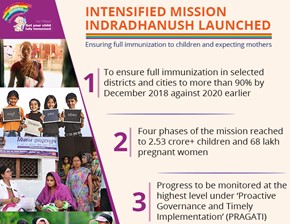
Importance of Vaccination
- Vaccines are one of the most effective, affordable and safe methods to protect infants, children and pregnant women from diseases and mortality.
- With the aim to achieve this, the Government launched Mission Indradhanush in 2014 to increase the full immunisation coverage.
- The mission focuses to cover the partially and unvaccinated pregnant women and children in pockets of low immunization coverage, high-risk and hard-to-reach areas and protect them from vaccine-preventable diseases.
- Moreover, the role of vaccines in public health is evident from its achievements in the country-wide COVID-19 vaccination drive under which around 170 crore doses have been administered till date.
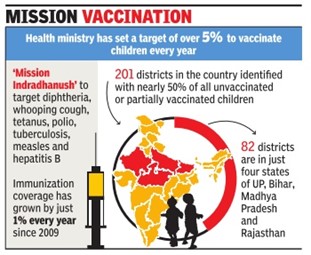
Source:
Kasparov-versus-computer chess match
On February 10, 1996, world chess champion Garry Kasparov began a six-round match against Deep Blue, a chess-playing computer built by IBM, in which Kasparov claimed a 4–2 victory (though Deep Blue won a rematch the following year). Kasparov was a Soviet-born chess master who became the world chess champion in 1985. Kasparov was the youngest world chess champion (at 22 years of age) and the first world chess champion to be defeated by a supercomputer in a competitive match. Deep Blue, computer chess-playing system designed by IBM in the early 1990s. As the successor to Chiptest and Deep Thought, earlier purpose-built chess computers, Deep Blue was designed to succeed where all others had failed.

Source:
Metaverse
In News
A British woman has alleged that she was verbally and sexually harassed in Facebook’s metaverse, Horizon Venues.
What is Metaverse?
- The metaverse can be defined as a simulated digital environment that uses augmented reality (AR), virtual reality (VR), and blockchain, along with concepts from social media, to create spaces for rich user interaction mimicking the real world.
- Technologies used in Metaverse include virtual reality (VR), augmented reality (AR), and brain-computer interfaces (BCI).
- A metaverse is an online world where digital identities (avatars) of people exist in shared virtual spaces.
- Metaverse merges digital and real-world identities, combining social media with gaming, augmented reality and cryptocurrency for a hybridized and integrated user experience.
- At its heart, the Metaverse is defined by its immersive experience for users.
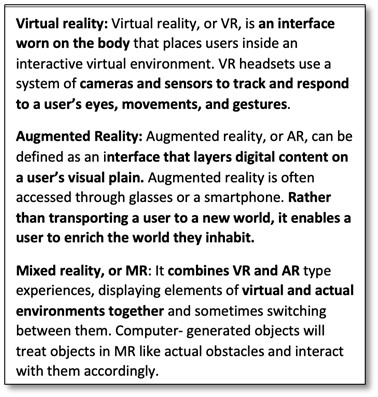
How does Metaverse affect the Human Mind?
- Psychological realness leads users of Metaverse/ immersive technologies to physiologically respond to virtual simulations in ways that are similar to their bodily response to real situations.
- It is the combination of immersion, presence, and embodiment that allow users to perceive they are in an alternative reality.
- Immersion: The user feels like they are in another environment. Content generates patterns of stimulation for the user.
- Specific embodiment aspects to the technology. This has been defined as “the illusion of non-mediation” or the impression that one feels like she is communicating without interfaces.
- Embodiment: or feeling like an avatar or virtual body is your physical body.
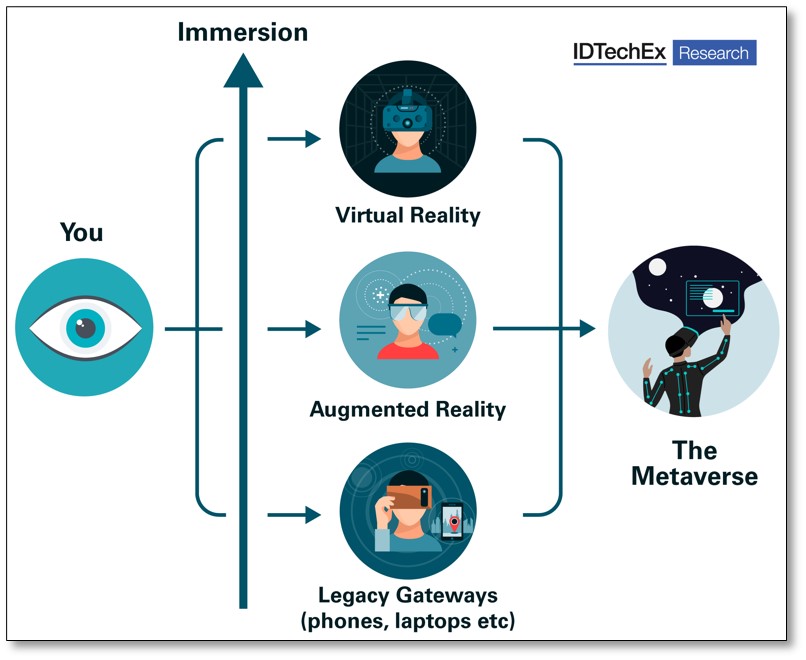
What can be the Potential Benefits of Metaverse?
- Innovative Communication for Work and Education: Instead of seeing the rest of the participants on a computer screen and communicating through microphones and speakers, Metaverse will enable one to see around and navigate through the virtual environment of office or lecture hall in a complete 360-degree fashion while interacting with life-like avatars of the participants.
- New Opportunities for Businesses and Marketers: Marketers can create digitized versions of their products or place storefronts in a shared virtual world that can be viewed and navigated through by users. The interactions between the target market and marketing contents and ads will be more immersive.
- Creating and Further Promotion of a Virtual Economy: The metaverse will provide a digital platform for an immersive exchange of digital and offline products and services. Note that these digital assets can have a real economic value. Furthermore, it will support the creation of new trade activities and jobs that exist in either the shared virtual space or the real world.
- Affordability of Experiences: Just like the internet has given much of the human population access to vast libraries of knowledge and entertainment, the Metaverse may allow most of humanity to virtually experience world travel, high quality interaction with family members stuck in distant countries, and so on.
- Sustainability: Metaverse will be a huge boon for sustainability. By attending workplaces, schools, and social gatherings virtually rather than physically, we will save precious resources.
- Gives Medical Professionals Powerful Insight On Patients: Modern medical equipment powered by Virtual reality has evolved after the integration of Metaverse technology. Doctors can detect and diagnose health problems much earlier due to the expanded visibility in the biological process.
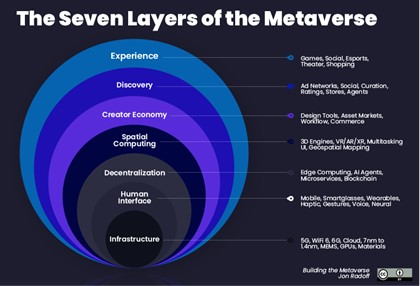
What can be the potential Issues with Metaverse?
- Safety-based features in Immersive experiences: Content moderation is a particularly tricky challenge for immersive technologies. These new technologies also create new avenues for online harassment and abuse. A person wearing the glasses can easily record their surroundings in secret.
- Mismatch with existing law: The area of immersive technology that has the highest potential for human rights abuses may be biometric data and its limitations, due to the type of information that can be collected and a fundamental mismatch with existing law.
- Biometric psychography: This term encompasses behavioural and anatomical information used to identify or measure a person’s reaction to stimuli over time, which provides insight into a person’s physical, mental, and emotional state, as well as their interests. What makes biometric psychography different than biometric data is that it reveals not only one’s present physical and/or emotional state, but what external triggers are provoking those responses.
- Virtual spaces may engender new types of social experiences, based on the ability to personify inanimate objects, create new environments, manipulate the laws of physics and nature, and embody different types of physical forms.
- Given the role that digital currencies are expected to play in the metaverse, the financial incentive and payment structures that lead to the proliferation of harmful content are likely to increase in size and complexity with the move to this web 3.0.
- May Erode Human Relationships and the Society: Artificial intelligence, which is one of the underlying technologies for designing and running the metaverse, is a “giant false god” that can create unhealthy and parasocial relationships.
How can Metaverse be optimally/sustainably used?
- Develop Value-based Heuristics and clear user understanding of Experience Rules to improve user safety. It is reasonable that communicating the rules of virtual experiences, in a short, clear, cogent and user-friendly way, would go a long way.
- Those designing virtual environments should understand that there are multiple levels where content moderation can take place in an immersive system. These include: the content layer, like individual immersive experiences (akin to software); the behavioural layer, which hosts user-to-user interactions and interactivity between users and the environment; and the account layer, where users register and access features of the immersive platform.
- Protection of Privacy can be ensured through meaningfully informed User Consent, combined with user-based control over data gathering and storage.
- Create Industry-wide Code of Conduct: At this point, where the immersive interfaces are constantly in flux and the industry is still evolving, it would be risky to develop legislation to address specific harms. Under the U.N. Guiding Principles for Business and Human Rights (UNDPs), companies have a roadmap to determine their role in promoting and implementing human rights.
- Regulators and legislators have faced similar problems when trying to integrate emerging online media into our social fabric and legal paradigms. Looking to social media, online harassment, and other challenges with integrating safety and freedom of expression in online spaces may offer a roadmap for anticipating and addressing emerging problems with immersive experiences.
Conclusion: Immersive technology is just like the atom splitting. It can be used for helping mankind, lifting mankind, or it can be used for destroying mankind. That's where we are with virtual reality. We're on the cusp of having powerful tools like fire. What are we going to do with it? How are we going to use it? How are we going to put in safeguards so that we don't get burned?
- Dr. Thomas Furness, Developer of first immersive technologies
Question: What is Metaverse? What can be the potential challenges that Metaverse may create?
Source:
New species of spider and millipede
These are images of recently discovered new species of spider from the Wayanad Wildlife Sanctuary and a new species of millipede from the University of Calicut campus, Tenhipalam. Carrhotus tholpettyensis, the new species of spider was found from the moist deciduous forest of Tholpetty range of the wildlife sanctuary in Western Ghats, a robust biodiversity hotspot. This nocturnal jumping spider retreats to hide under leaves during day time and comes out only in the night for feeding. New species of millipede, named as Delarthrum anomalans, belongs to the family Paradoxosomatidae, a group of minute millipedes. The body is composed of 20 segments with 52 legs. These flat millipedes live under leaf litter. They hide beneath the soil during the span of the dry period and resurface only in the wet season.


Source:
Geomagnetic storm - Edukemy Current Affairs
- Context: A geomagnetic storm had recently knocked up to 40 SpaceX high-speed internet satellites that were launched to a low deployment orbit, 130 miles above Earth.
- A geomagnetic storm is a major disturbance of Earth's magnetosphere that occurs when there is a very efficient exchange of energy from the solar wind into the space environment surrounding Earth.
- These storms result from variations in the solar wind that produces major changes in the currents, plasmas, and fields in Earth’s magnetosphere.
- The solar wind conditions that are effective for creating geomagnetic storms are sustained for several to many hours periods of high-speed solar wind.
- This condition is effective for transferring energy from the solar wind into Earth’s magnetosphere.
- While the storms create beautiful aurora, they also can disrupt navigation systems such as the Global Navigation Satellite System (GNSS) and create harmful geomagnetic induced currents (GICs) in the power grid and pipelines.

Source:
Indian Footwear and Leather Development Programme (IFLDP)
- Context: Ministry of Commerce has recently approved IFLDP for continuation from 2021-22.
- IFLDP is a Central Sector Scheme launched in 2017 with the aim of developing infrastructure for the leather sector.
- It focuses on addressing environmental concerns specific to the leather sector, facilitating additional investments, employment generation and production increase.
- The core objective of the IFLDP is to enable creation of world-class infrastructure to cater to the domestic market and exports.
- IFLDP consists of six sub-schemes namely: Mega Leather, Footwear and Accessories Cluster Development (MLFACD); Integrated Development of Leather Sector (IDLS); Sustainable Technology and Environmental Promotion (STEP); Promotion of Indian Brands in Leather and Footwear Sector; Development of Design Studios; and Establishment of Institutional Facilities.
- India, being the second largest producer of footwear, exporter of leather garments, and third largest exporter of saddlery items must lay due emphasis on this sector as it is an employment intensive sector that provides job opportunities to about 4.42 million people.
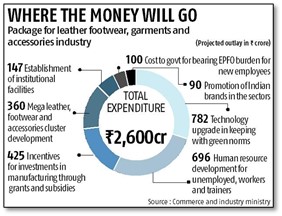
Source:
Operation AAHT
- Context: The Railway Protection Force has recently launched “Operation AAHT”.
- Operation AAHT is a nationwide operation to curb human trafficking.
- Human Trafficking, especially of women and children, for sexual exploitation, forced marriage, domestic servitude, organ transplant, drug peddling etc is an organised crime and the most abominable violation of human rights.
- The Indian Railways, that operate about 21,000 trains across the country and transports about 23 million passengers each day, is the largest, fastest and most reliable carrier for suspects who traffick women and children.
- Therefore, as a part of the operation, special teams will be deployed on all long-distance trains/routes with focus on rescuing victims, particularly women and children, from the clutches of traffickers.
- The infrastructure and intelligence network of the protection force will be utilised to collect, collate and analyse clues on victims, source, route, destination, popular trains used by suspects, identity of carriers/agents, kingpins etc. which will be shared with other law-enforcing agencies.
- Through this, the RPF would act as a bridge cutting across States to assist the local police in the mission to curb the menace.
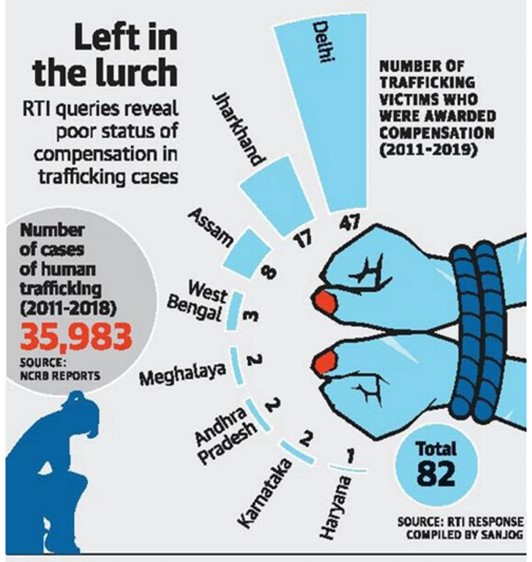
Source:
Sowa-Rigpa
- Context: Indian Institutes and organisations working in the field of (AYUSH) had shared their expertise on various traditional system of medicines in the management of Covid-19 and NCD.
- Sowa-Rigpa, commonly known as “Amchi system of medicine” is one of the oldest, living and well documented traditional medicine system of the world.
- The term ‘Sowa-Rigpa’ is derived from the Bhoti language which means ‘Knowledge of Healing’.
- The majority of theory & practice of Sowa-Rigpa is similar to and influenced by 'Ayurveda' and the knowledge of it is passed either through the traditional guru-shishya system or family lineage system.
- It has been popularly practiced in Tibet, Mongolia, Bhutan, some parts of China, Nepal and Himalayan regions of India.
- In most of Himalayan regions, Sowa-Rigpa is practiced with community support with an Amchi in every village.

Source:
Achieving Gati Shakti: Breakthrough Paradigms Needed: FE
Essence: The article emphasizes that having more information about chaos does not help you manage chaos better. This statement holds true when it comes to India considering the implementation of Gati Shakti. To reap the benefits of this plan, the first thing that is required to be sorted is delivery of projects. The second thing to be taken care of is the traffic management which gets slowed down due to building of new roads. The last thing that needs improvement is the supply chain management which includes learning how to have right inventory.
It is the right time industry and government steps in to executes the project in half the time. This will ensure that twice the infrastructure is delivered in short span of time. The industries should rework on the system to reduce the safety stocks. Last but not the least local and state government must improve their management of traffic so that it can flow with its intended speed. All of this requires different set of execution paradigms, not more dashboards.
Why you should read this article?
- To understand the factors that is inhibiting India from realizing potential of Gati Shakti.
- To understand the steps that government and industry should take to reap the benefits of Gati Shakti.
Source:
Iran Nuclear Talks: The Stakes are high in Vienna: HT
Essence: The author highlights an emerging crisis that deals with JCPOA and Iran’s nuclear enrichment program. Two nuclear powers, USA and Israel have greater reasons to raise stakes and opt for preventive attacks, a military route to prevent Iran’s nuclear pursuit. Israel has motivation- with a small geographical expanse, it could be very difficult to raise a counterattack. In addition, Iran could leverage the availability of nuclear arsenal to preserve its strategic/offensive/territorial gains or subjugate its rivals into action/inaction. Eg blockade of Strait of Hormuz. It also might lead to a domino/snowball effect- possession of weapons by non-state actors, proliferation, etc.
USA, on the other hand, has greater opportunity to drop bunker buster bombs. But its motivation of war is not strong due to its strategic engagements with Russia at Ukraine front and China at South China Sea region. In either cases of attack or no attack, Iran might still pursue its nuclear program.
Why should you read this article?
- To understand the reasons for preventive attacks on Iran by superpowers.
- To know the strategic reasons of motivation and opportunity available with Israel and USA to withhold Iran’s nuclear program.
Source:
How a digital university can transform India’s education system: HT
Essence: The absence of a sufficient number of universities limits the alternatives available to prospective students, which has got compounded by the pandemic. The National Education Policy (NEP) 2020 sets the path to address this issue. The emergence of digital technology has forced us to reconsider our teaching and learning methods. As a result, educators and policymakers believe that in order to achieve the economies of scale required in India, universities must restructure their operations and provide flexible educational institutions using a combination of digital media and information technology for online education. Budget 2022-23 announced the creation of a digital university keeping with the NEP's vision. The ability to develop cutting-edge information and communications technology platforms and digital content, as well as the ability to collaborate with the best public higher educational institutes to provide an affordable world-class teaching-learning ecosystem, are all advantages of a digital university. The launch of the digital university, which coincides with India's "Azadi Ka Amrit Mahotsav," has the potential to position India as a significant provider of higher education to both Indian and international students.
Why should you read this article?
- To gain a better understanding of the issues faced by India's higher education system, as well as how digital technology has forced us to rethink our teaching and learning methods.
- To have an understanding of the benefits of digital universities in India.
Source:
Girl Student Empowerment through STEM
Background
- Students need to be exposed to scientific concepts at an early age, to be able to appreciate the rigour of academic research, and to build up the confidence to take up academics as a career choice when they grow up.
- As women participation in Science, Technology, Engineering and Mathematics (STEM), an IIT Delhi initiative aims to bridge this gap.
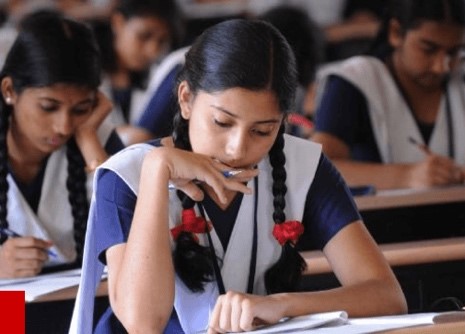
About the IIT-Delhi Initiative
- The Indian Institute of Technology (IIT) Delhi has launched the STEM (Science, Technology, Engineering, Mathematics) Mentorship Program for Class XI girls from government schools to encourage them to choose science as their career.
- The primary objectives of the program, designed for Class XI girl students, are to train young students to think creatively about science and innovation, to provide them novel hands-on experience in solving research problems, and to help them form a stronger knowledge foundation.
- For the first batch 10 Kendriya Vidyalayas girls from Delhi have been shortlisted, who will be mentored by professors from IIT-D in their chosen topics of interest. They will also get access to research scholars under these professors.
- They will be imbibed with foundational concepts in STEM disciplines, along with the experimental methods and techniques used in science labs.
- The idea behind the initiative is to encourage girls into participating in the STEM discipline and join the field of science in future as a career option.
- Later, the initiative will cover other parts of the country as well.
Quote: “Women share this planet 50/50 and they are underrepresented – their potential astonishingly untapped.”-Emma Watson
Source:
Share the article
Get Latest Updates on Offers, Event dates, and free Mentorship sessions.

Get in touch with our Expert Academic Counsellors 👋
Frequently Asked Questions
UPSC Daily Current Affairs focuses on learning current events on a daily basis. An aspirant needs to study regular and updated information about current events, news, and relevant topics that are important for UPSC aspirants. It covers national and international affairs, government policies, socio-economic issues, science and technology advancements, and more.
UPSC Daily Current Affairs provides aspirants with a concise and comprehensive overview of the latest happenings and developments across various fields. It helps aspirants stay updated with current affairs and provides them with valuable insights and analysis, which are essential for answering questions in the UPSC examinations. It enhances their knowledge, analytical skills, and ability to connect current affairs with the UPSC syllabus.
UPSC Daily Current Affairs covers a wide range of topics, including politics, economics, science and technology, environment, social issues, governance, international relations, and more. It offers news summaries, in-depth analyses, editorials, opinion pieces, and relevant study materials. It also provides practice questions and quizzes to help aspirants test their understanding of current affairs.
Edukemy's UPSC Daily Current Affairs can be accessed through:
- UPSC Daily Current Affairs can be accessed through Current Affairs tab at the top of the Main Page of Edukemy.
- Edukemy Mobile app: The Daily Current Affairs can also be access through Edukemy Mobile App.
- Social media: Follow Edukemy’s official social media accounts or pages that provide UPSC Daily Current Affairs updates, including Facebook, Twitter, or Telegram channels.

